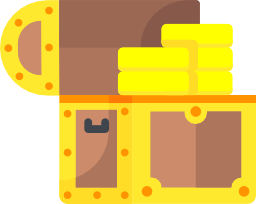The 5-Step Journey
to realizing your creative potential
Have you always wanted to be creative, make games, or start a company? Do you find yourself getting stalled and not knowing where to start? Do you get stuck half-way through and give up? Don’t worry, you are in good company! I wrote this book to break down the creative process in a simple step-by-step way that busts through creative blocks and gets you living out your creative dreams in no time!
What’s inside
Understanding Game Design
Master The Core Design Loop
Refine Your Designs
Build Your Vision
Selling Your Game
Game Design as a Career
Introduction
It was the biggest moment of my career,
and I was ready to throw up.
Standing behind the stage at San Diego Comic Con,2008, I peeked out behind the curtain to see 2,500 fans anxiously waiting for me to get on stage. The hum of the crowd permeated the room. I calmed my nerves before stepping out to announce my first major game design project: the World of Warcraft Miniatures Game.
This was the first time the public would see what I’d devoted more than three years of my life to creating. For me, this was the pinnacle of more than a decade I had spent in the gaming industry. Little did I know it was only the beginning….
If you are the kind of person who likes to play games, at some point you’ve probably thought, “Wouldn’t it be sweet to make games for a living?” This book will show you how to do just that. It will also answer all of the common questions that come after: How do I get started? What if I get stuck?
How do I get published? How do I make money? What if I’m not good enough?
I’ve been in the gaming industry for twenty years, and I’ve learned a lot along the way. I dropped out of law school with no idea how to make games, but I taught myself how to follow my passion.
In the process of writing this book, I’ve spoken with dozens of the world’s best designers to learn more about the craft. I’ve found a remarkable consistency in how each person approaches design. Each designer brings his or her own style and methods to the process, but the underlying principles are universal. There is a simple, learnable process for becoming a great game designer, and I share that process in these pages.
Perhaps, like I did, you have apprehensions about being “creative.” I first got my start in the game industry more than twenty years ago when I won the US National Magic: The Gathering Championships. For those who aren’t familiar with it, Magic: The Gathering is a trading card game where players select from thousands of cards to build their own decks and compete against others. Think of it like a cross between chess and poker, where you get to select your own pieces at the start of the game. That championship launched a career that would take me around the world to tournaments in London, Sydney, Tokyo, and Rome. I made lifelong friendships and earned enough money to pay my way through college, while learning a ton about myself and the world around me. It was this tournament success that got me my first job as a developer for a Marvel vs. DC Comics trading card game.
I was hired because I was good at playing games, but I had no idea how to create them. In fact, I had never thought of myself as a “creative” guy. My approach was always analytical, breaking games down into their constituent parts so I could figure out how to win. It is this very process of breaking things down that led me to the principles I will share in this book and a profound insight: There are no “creative people.”
There are only people who follow this process in one form or another. The only prerequisite to being a game designer is a passion for making games and a willingness to do the work of iterative design. All the information you need to get started is available in this book.
Since beginning my career, I’ve started my own company, launched multi-million dollar games in both digital and tabletop form, and had the chance to work directly with some of the most brilliant minds in the industry. I’ve also made spectacular errors, faced near bankruptcy more than once, and am constantly learning from my mistakes. These pages contain lessons from both my successes and my failures so your learning process can be smoother than mine!
Teaching has always been a passion of mine. I firmly believe that the best way to master a subject is to teach it to others. I’ve lectured at schools and conventions. I’ve hired and trained designers using these methods. I’ve gotten everyone from grade-schoolers to senior citizens designing and creating their own games during a single two-hour class! After years of refinement, I’ve decided to codify these principles in writing so anyone can access them.
If you follow the step-by-step exercises in each chapter, you will be a game designer. Practicing and reviewing these principles with an open mind is all that stands between you and seeing your designs come to life. These principles work.
And, as we’ll see later in this book, they apply not just to making games, but to any creative endeavor. If you want to begin a career in game design, learn how to think like a game designer, or improve your thinking process for any creative challenge, this book has something for you.
In these pages, we will review everything from initial concept to final publication of a game in a way accessible to a novice, but with enough detail that even experienced designers will find value. I learned a lot in the process of writing this book, and it is my sincere hope that I will learn from all of you as you take these principles and expand on them in your own work. The community of game designers is a wonderful and inspiring one, and I am honored to welcome you to it. The process of learning a craft like game design is a lifelong one. I hope this book serves as a powerful touchstone on your journey.
Chapter 1
Learning Fundamentals
“Success is neither magical nor mysterious. Success is the natural consequence of consistently applying the basic fudamentals.”
WHAT IS A GAME DESIGNER?
Think back to a memorable game-plaing expereince from your past. Picture where you were and whom you were with. Take a moment and zoom in on what was going on in your experience that made it so memorable.
Were you able to snatch victory from the jaws of defeat (or vice-versa)?
Were you laughing and connecting with friends and loved ones?
Did you flip over the table in frustration?
Notice that whatever you particular story, the strong emotional reaction to the experience of play is what resonates with you today. That experience emerges from not just the game rules and components, but also from the environment, the people around you, and each player’s background assumptions.
A game designer’s job is to craft that experience.
This job makes the broad definition of a game designer very simple: A game designer, like any other artist, aims to create an experience for the audience.
Games, however, have several unique features that separate them from other crafts. Those unique features are:
1. Games have players.
2. Games have rules.
3. Games are interactive.
These elements allow us to create a good starting point for a more precise definition of a game designer:
A game designer uses the interaction of players and rules to create an experience for the audience.
The audience is usually the players, but it can sometimes be viewers (e.g., at game shows, sports events, etc.). Many games are built with a viewing/streaming audience in mind, and e-sports are becoming a larger part of the gaming community each year. The same principles apply in either case, but in this book, we will assume your players are your audience.
WHAT MAKES A GREAT GAME DESIGNER?
To be a great game designer, you must be able to predict your players’ emotional responses to the rules you design. Predictions require a degree of empathy and the ability to understand why people play games.
A great game designer must both predict the actions that players will take within a given game and understand how those actions will make players feel. To some of you, this definition may sound a bit wishy-washy.
“We have to talk about feelings?” Yup, there is no escaping it. Our job as game designers can be described as working in a feeling factory. Only by understanding our own feelings and emotional reactions to games can we empathize well enough with others to do our jobs well. Get ready to get uncomfortable!
HOW DO I BECOME A GREAT GAME DESIGNER?
Game designers become great through practice and attention. Three precursor habits need to be developed to become a great game designer:
1. Play lots of games.
2. Watch people play lots of games.
3. Bring awareness to the emotions that arise during play.
These habits will develop your intuition and improve your designs. Developing a habit of observing your players and taking in feedback (both explicit and implicit) will allow you to transform your initial concepts into great games.
WHERE DO I START?
No matter the type of game you eventually want to make, one of the best places to start learning the art of game design is through traditional board and card games.
The reason is those games have a very low iteration cost.
You can try out an idea, test it, get feedback, and repeat the cycle with little overhead. This process allows you to learn what works and what doesn’t, thus improving your design skills.
Playing games (even bad ones) is also valuable for learning more about game design. A great place to begin is with your favorite games. Figure out what about those games attracts you. Pay attention to those moments when you notice yourself or other players having intense emotional responses (both good and bad). Take note of what led to those emotions and think about how you could evoke them (or avoid them) in your own designs.
THE MOST IMPORTANT CONCEPT IN GAME DESIGN
The most important concept to understand as a game designer is what I call the core design loop. Every great designer uses this fundamental creative process in one form or another. Even if you think you are not creative, this process will get you creating in no time. The core design loop has six steps:
1. Inspiring: Decide what type of experience you will create.
2. Framing: Assess your parameters and deadlines.
3. Brainstorming: Get your ideas down on paper.
4. Prototyping: Bring your best ideas to life.
5. Testing: Learn what works and what doesn’t.
6. Iterating: Use what you learned to improve the cycle.
As a general rule, the faster you can move through the above cycle (and the more iterations you get), the better your game will be. We will unpack all of those steps in detail in the upcoming chapters.
Justin’s Exclusive
Design Lessons
Every week, I’ll send out a newsletter with awesome stuff that you can use to push yourself creatively, design games, and even join in on some adventures. You’ll also get exclusive access to webinars, events, and discounts.
Enter your email to start your journey and get exclusive content, private Q&As, giveaways and more.









